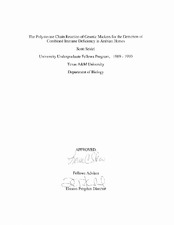| dc.description.abstract | Combined immune deficiency, or CID, is a lethal genetic disease that affects humans and a variety of animals. In horses, it is inherited as an autosomal recessive gene, and occurs mainly among members of the Arabian breed. However, even though the inheritance pattern has been documented, the etiology of CID is still largely unknown. Several accompanying conditions have been described, including deficiencies in thymus and marrow-derived lymphocytes, and abnormalities in nucleic acid metabolism. In addition, studies in other species indicate that several different genetic defects on different chromosomes may cause heritable CID.
CID accounts for the death of approximately 2.3 % of the North American Arabian foals, and it is estimated that 30% of the population of North American Arabian horses are carriers of this disease and transmit it as asymptomatic carriers. The high frequency of this disease suggests that the elimination of the defective gene from this horse breed would be highly advantageous to Arabian horse breeders. The elimination of this disease requires a reliable, accurate means of detecting asymptomatic CID carriers. This would allow elimination of the disease through selection of non-carriers as breeding stock.
A genetic marker for the CID gene would fulfill the need for a diagnostic test. However, the CID gene itself has not been isolated, and a large-scale search for the CID gene is not feasible at this time. One alternative is to examine genetic sequences on the same chromosome closely linked to the CID gene. These sequences, due to their proximity to the CID gene, would tend to be inherited along with it. Therefore, sequence markers (polymorphisms) linked to the recessive CID gene would be homozygous in affected CID foals, and heterozygous in the carrier parents. In this way, by following the transmission of the known genetic markers, the transmission of the CID gene may be followed as well. This technique, called "homozygosity mapping," has been proposed for use in detecting recessive genetic disorders in humans. | en |


